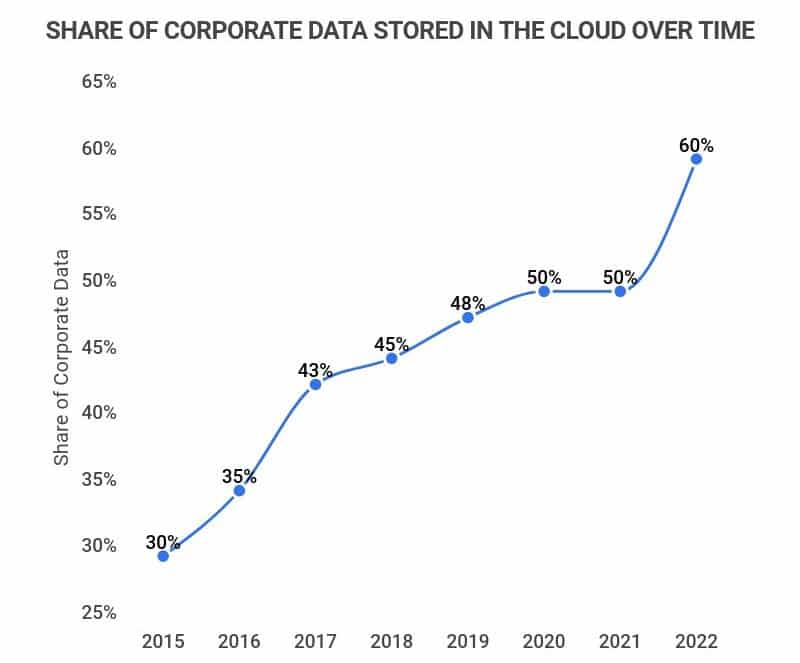The Key Benefits and Challenges of Moving to the Cloud
The Key Benefits and Challenges of Moving to the Cloud
If you’re reading this article, you probably already use the cloud and have your own thoughts regarding the pros and cons of cloud migration. 94% of all enterprises already use the cloud in the US, with similar numbers throughout the rest of the world. And as the percentage of companies that use the cloud for at least some of their processes approaches 100%, the share of companies that use anything other than the cloud is diminishing.
So while your company uses the cloud for something already, the real question is whether it’s time to move everything over to the cloud, a process known as cloud migration.
Since you already use the cloud a bit, you’ve got some ideas of the benefits of the cloud. But we’ll still spell them out for you in detail, and then outline the challenges of migrating to the cloud, along with outlining exactly how you might go about migrating over. Essentially, we’ll give you all the tools you need to form a successful cloud migration strategy, so let’s get started!
The Benefits of Cloud Migration
Cost benefits
Of course, the first reason that any business takes any otherwise disruptive decision is the ROI. Once you’ve migrated, the cost of running your operations on a cloud provider is going to be significantly cheaper than buying, running, and in-house maintaining hardware and software. One of the things you pay cloud providers for is all that work, which saves money you otherwise would have spent, but also obviously time.
On top of that, cloud computing allows you to pay for the time you use, with a variety of packages. When you do everything in-house, you’re almost certainly paying for time that you don’t use.
Enhanced Scalability
One of the features of modern business is that your campaign can take off in a hurry. If you go viral, or even if you grow just from word of mouth, it can take a matter of hours for traffic to shoot through the roof. Cloud computing is built to handle spikes and increased server usage without slowing the system as a whole down. This means you can scale your resources as your needs demand much more easily than if you have a whole hardware set up for one reality.
An Improved Customer Experience
Customers are more mobile than ever before, meaning they need to be able to access your databases and servers from anywhere at any time. If those are all in-house, naturally the farther away your customers are then the more likely it is that they’ll experience latency. Cloud computing ensures that they’ll simply access the nearest data centers, so that your business can operate on a level that’s just as mobile as your customers.
Increased Performance
Technology improves at an incredibly fast rate in the modern world, and that means that all of your components need to be cloud-compatible if you’re going to migrate to the cloud. Getting everything modernized at once means your business can be as cutting edge as possible. If you’re still dealing with hardware that needs to be constantly upgraded, you’ll constantly be facing issues about whether upgrading is worth the cost, as opposed to simply having all the necessary infrastructure to run your business through an up-to-date cloud.
What are the most common challenges associated with cloud migration?
Insufficient Strategy
Not surprisingly, given differences and benefits from in house computing systems, migrating to the cloud requires a ton of preparation. You need to think about the cost effective and efficient method of moving to the cloud, with a fully formed cloud migration strategy before you begin.
Budgeting and Cost Control
There are several ways to move to the cloud, from something closer to a “lift and shift” strategy, which simply lifts existing infrastructure over to the cloud, to completely rebuilding your cloud computing infrastructure to be optimally compatible with the cloud. There are different levels of optimizing your computing infrastructure to the cloud, with different costs associated with each, and it’s up to you to organize a strategy that works best for your needs and your company.
You can also check our report to understand cloud computing’s financial and operational benefits for businesses in detail.
Data Security and Compliance
The cloud may be more secure in a number of ways, but ultimately you need a different set of training to ensure data security and compliance in the cloud than on premises computing. Staff training is incredibly important, and everyone needs to know how to manage the services they’ll be handling. An AWS partner hired specifically to manage the project may also be necessary, depending on the specific strategy.
An Overview of the Cloud Migration Process
Careful Migration Planning Strategy
As we’ve outlined, you need to know the strategy that works best for you and your needs. There are a lot of different ways to migrate to the cloud and you need to carefully pick which way will work best for your company.
Choose your Cloud Environment
There are lots of different kinds of cloud models, and some companies opt to choose a single cloud to handle all their needs, and other companies choose a hybrid model of mixing and matching to suit what works for them. So, you should know before you move whether you want IaaS (like Virtual Machines or AWS EC2), PaaS (like Elastic Beanstalk or Lambda from AWS), or SaaS (like Oracle ERP/HCM Cloud, SalesForce, or Gmail).
Execute your Strategy Perfectly
Obviously, part of this means that your strategy has to involve every step possible to ensure the migration itself is executed to perfection. One thing to keep in mind is that data protection is of the utmost importance during this process. When things are in transition, that’s when security is at its highest risk. So, you need to have a concrete plan for security and data protection during the migration process, as well as before and after.
Maintenance
Of course, once you’ve successfully moved everything to the cloud, you need to ensure that security and privacy are optimized and always updated, as well as being easily retrievable. One of the advantages of the cloud is that it’s flexible, because you know that business will get better and worse during different periods. As you scale up and down, you need to make sure that all other processes are optimized and secure.
Key Takeaways
In summary, moving to the cloud – to at least some degree – is essential to running a modern business. Given that fact, you really should have a fully formed strategy for how, when, where, why, and what to do about it. You need to know exactly what type of cloud migration is best for your business, and then spend the time and energy to form a comprehensive strategy to complete that move. Commencis Cloud Solutions excels in helping businesses through exactly this process, and to making sure that your business is optimized and stores its data in the most efficient and effective manner possible.
Reading Time: 5 minutes
Don’t miss out the latestCommencis Thoughts and News.





